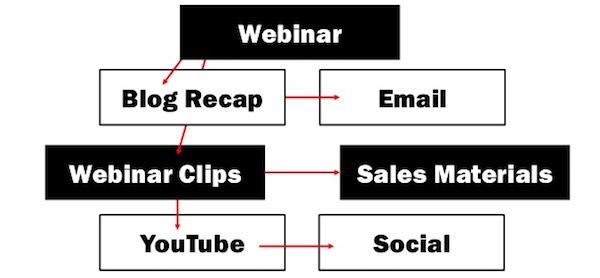ADVERTISEMENT
It’s hard to continuously come up with new ideas. Especially great ideas.
In content marketing, it’s all about the idea. A great idea that engages people is the real key to content marketing success. It’s not about the content type or format or what platform it’s published on.
Some companies don’t have the time, resources, and money to create new content.
The solution? Repurpose your existing content!
Hollywood loves repurposing. How many prequels, sequels, reboots, and remakes have you watched just in the past year?
But there’s a reason why Hollywood does this: they’ve figured out they don’t need to come up with new ideas.
Those movies were successful. They made money. They are proven ideas.
You should do the same thing with your proven content.
Why reinvent the wheel when you can just realign it?
Here’s how to repurpose your most successful content like a champion. This content repurposing process comes from Casie Gillette, director of online marketing at KoMarketing, who spoke this week at Pubcon SFIMA in Fort Lauderdale, Florida.
1. Use Your Data
Your content needs to have a goal, whether it’s generating organic search visibility, traffic, leads, or shares. You can’t measure the results of anything unless you set goals at the beginning.
Start by looking at your data to see what has worked. What types of content have driven results for you over the past couple of years?
Look at your data to see which pages have the most:
- Views. Use your analytics to see which content brought in the most traffic.
- Referrals. Use your analytics to figure out which content was good enough for someone to link to or share.
- Organic visibility. Use a tool (e.g., SEMrush) to look at your rankings, traffic, and the terms driving that traffic.
- Links. Use a tool (e.g., Google Search Console) to see your top linked pages. These might not drive the most traffic, but people thought this content was good enough to link to.
- Shares. Use a tool (i.e., BuzzSumo) to see which content people thought was worth sharing.
All of these individual data points will give you a clearer picture of your successes. Now it’s time to replicate them.
2. Repurposing Your Content
Content repurposing comes in a couple of flavors.
Refresh & Republish
New ideas aren’t always better. Take something existing and refresh it.
Sometimes you have a piece of content (e.g., an ebook) that consistently ranks well, drives traffic, and generates leads or shares. But after a couple of years, the information becomes old and out of date.
Rather than taking it offline (don’t do this!), refresh it and republish it.
Creating a new ebook (or another types of content) takes time, money, and resources – for research, writing, graphics, production, etc.
It’s much smarter to update the statistics, visuals, and any other outdated information.
If you change the URL, add a redirect from the old piece of content to the new piece so you keep driving traffic and shares. Or simply replace the old content with the new at the same URL.
Use your editorial calendar to keep track of content that needs regular updates. Make content refreshing and republishing part of your editorial process.
Reformat
There are endless possibilities for turning one piece of content into another format. Popular blog posts can become whitepapers, ebooks, videos, social content, GIFs, email, or something else.
Ultimately, the content type you choose depends on your goals and data.
Let’s look at one example of how you can easily turn one content asset – a webinar – into six.
Think about it. If you run a webinar, you promote the heck out of it for two or three weeks before it happens using email blasts.
What do you do after the webinar? Most companies do nothing.
Don’t let your existing content sit unused and forgotten. Instead, do something like this:
Repurpose the:
- Webinar into a blog recap, which includes a link to the full webinar and related webinars.
- Webinar blog recap into an email. Send it to all the people who registered for the webinar (or your entire customer base) and include a link to the webinar.
- Webinar into short clips (e.g., 2 minutes) that are interesting and more digestable than a full webinar.
- Webinar clips into sales materials.
- Webinar clips as YouTube videos (or Facebook or other relevant video platforms).
- YouTube videos as social content to help promote the clips and help more people discover your webinar.
All of this content repurposing has the potential to drive more shares, links, search visibility, and leads.
Think of all the different ways you can use one piece of content to maximize it across multiple channels. Take advantage of everything you have.
3. Measure Your Results
Did it work? You’ll know pretty quickly whether your repurposed content achieved its goals.
Check your analytics after about 30 days to evaluate whether your repurposed content generated more organic traffic, leads, or social shares/engagement.
Image Credits:
Featured Image: Depositphotos
Article Image: Casie Gillette – Repurposing Content for Results
Go to Source
Author: Danny Goodwin
The post How to Repurpose Your Content Like a Champion by @MrDannyGoodwin appeared first on On Page SEO Checker.
source http://www.onpageseochecker.com/how-to-repurpose-your-content-like-a-champion-by-mrdannygoodwin/

No comments:
Post a Comment